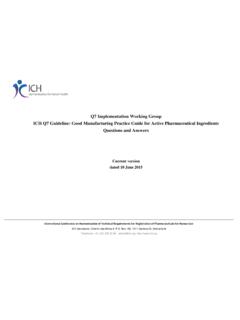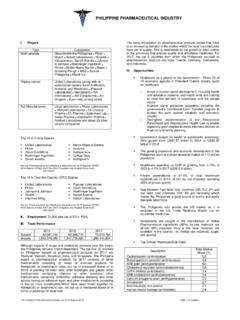Transcription of Annex 1 WHO good practices for pharmaceutical quality ...
1 81 World Health OrganizationWHO Technical Report Series, No. 957, 2010 Annex 1 WHO good practices for pharmaceutical quality control laboratoriesGeneral considerations Glossary Part one. Management and infrastructure 1. Organization and management 2. quality management system 3. Control of documentation 4. Records 5. Data-processing equipment 6. Personnel 7. Premises 8. Equipment, instruments and other devices 9. Contracts Part two. Materials, equipment, instruments and other devices 10. Reagents 11. Reference substances and reference materials 12. Calibration, verifi cation of performance and qualifi cation of equipment, instruments and other devices 13. Traceability Part three. Working procedures 14. Incoming samples 15. Analytical worksheet 16. Validation of analytical procedures 17. Testing 18. Evaluation of test results 19.
2 Certifi cate of analysis 20. Retained samples Part four. Safety 21. General rules References AppendixEquipment for a fi rst-stage and medium-sized pharmaceutical quality control 11:0382 General considerationsThe WHO Expert Committee on Specifi cations for pharmaceutical Products adopted in 1999 the guidelines entitled WHO good practices for national pharmaceutical control laboratories, which were published as Annex 3 of the WHO Technical Report Series, No. 902, 2002. As the other guidelines related to laboratory quality assurance have been updated and subsequent inspections for the compliance with the guidelines on good practices for national pharmaceutical control laboratories indicated that some sections were in need of improvement and clarifi cation, it was considered necessary to prepare a revised guidelines provide advice on the quality management system within which the analysis of active pharmaceutical ingredients (APIs)
3 , excipients and pharmaceutical products should be performed to demonstrate that reliable results are with the recommendations provided in these guidelines will help promote international harmonization of laboratory practices and will facilitate cooperation among laboratories and mutual recognition of attention should be given to ensure the correct and effi cient functioning of the laboratory. Planning and future budgets should ensure that the necessary resources are available inter alia for the maintenance of the laboratory, as well as for an appropriate infrastructure and energy supply. Means and procedures should be in place (in case of possible supply problems) to ensure that the laboratory can continue its guidelines are applicable to any pharmaceutical quality control laboratory, be it national, commercial or nongovernmental.
4 However, they do not include guidance for those laboratories involved in the testing of biological products, vaccines and blood products. Separate guidance for such laboratories is guidelines are consistent with the requirements of the WHO guidelines for good manufacturing practices (1) and with the requirements of the International Standard ISO/IEC 17025:2005 (2), and provide detailed guidance for laboratories performing quality control of medicines. The guidance specifi c to microbiology laboratories can be found in the draft working document WHO guideline on good practices for pharmaceutical microbiology laboratories (reference ).The good practice outlined below is to be considered as a general guide and it may be adapted to meet individual needs provided that an equivalent level of quality assurance is achieved.
5 The notes given provide clarifi cation of the text or examples; they do not contain requirements which should be fulfi lled to comply with these 11:0383 pharmaceutical quality control testing is usually a matter of repetitive testing of samples of APIs or of a limited number of pharmaceutical products, whereas national quality control laboratories have to be able to deal with a much wider range of pharmaceutical substances and products and, therefore, have to apply a wider variety of test methods. Specifi c recommendations for national pharmaceutical quality control laboratories are addressed in the following text. Particular consideration is given to countries with limited resources wishing to establish a governmental pharmaceutical quality control laboratory, having recently done so, or which are planning to modernize an existing control laboratories may perform some or all quality control activities, sampling, testing of APIs, excipients, packaging materials and/or pharmaceutical products, stability testing, testing against specifi cations and investigative the quality of a medicine sample to be correctly assessed: The submission of a sample of an API, excipient or pharmaceutical product or a suspected counterfeit material to the laboratory, selected in accordance with national requirements, should be accompanied by a statement of the reason why the analysis has been requested.
6 The analysis should be correctly planned and meticulously executed. The results should be competently evaluated to determine whether the sample complies with the specifi cations or other relevant pharmaceutical quality control laboratoriesThe government, normally through the national medicines regulatory authority (NMRA), may establish and maintain a pharmaceutical quality control laboratory to carry out the required tests and assays to verify that APIs, excipients and pharmaceutical products meet the prescribed specifi cations. Large countries may require several pharmaceutical quality control laboratories which conform to national legislation, and appropriate arrangements should, therefore, be in place to monitor their compliance with a quality management system. Throughout the process of marketing authorization and postmarketing surveillance, the laboratory or laboratories work closely with the national pharmaceutical quality control laboratory provides effective support for an NMRA acting together with its inspection services.
7 The analytical results obtained should accurately describe the properties of the samples assessed, permitting correct conclusions to be drawn about the quality of the samples of medicines analysed, and also serving as an adequate basis for any subsequent administrative regulations and legal 11:0384 National pharmaceutical quality control laboratories usually encompass essentially two types of activity: compliance testing of APIs, pharmaceutical excipients and pharmaceutical products employing offi cial methods including pharmacopoeial methods, validated analytical procedures provided by the manufacturer and approved by the relevant government authority for marketing authorization or validated analytical procedures developed by the laboratory; and investigative testing of suspicious, illegal, counterfeit substances or products, submitted for examination by medicine inspectors, customs or ensure patient safety, the role of the national pharmaceutical quality control laboratory should be defi ned in the general pharmaceutical legislation of the country in such a way that the results provided by it can, if necessary, lead to enforcement of the law and legal defi nitions given below apply to the terms as used in these guidelines.
8 They may have different meanings in other criterion for an analytical resultPredefi ned and documented indicators by which a result is considered to be within the limit(s) or to exceed the limit(s) indicated in the specifi degree of agreement of test results with the true value or the closeness of the results obtained by the procedure to the true value (1).Note: It is normally established on samples of the material to be examined that have been prepared to quantitative accuracy. Accuracy should be established across the specifi ed range of the analytical procedure. It is generally acceptable to use a spiked placebo which contains a known quantity or concentration of a reference pharmaceutical ingredient (API)Any substance or mixture of substances intended to be used in the manufacture of a pharmaceutical dosage form and that, when so used, becomes an active ingredient of that pharmaceutical dosage form.
9 Such substances are intended to furnish pharmacological activity or other direct effect in the diagnosis, cure, mitigation, treatment, or prevention of disease or to affect the structure and function of the body (1). 11:0385analytical test reportAn analytical test report usually includes a description of the test procedure(s) employed, results of the analysis, discussion and conclusions and/or recommendations for one or more samples submitted for testing (see Part three, sections ).analytical worksheetA printed form, an analytical workbook or electronic means (e-records) for recording information about the sample, as well as reagents and solvents used, test procedure applied, calculations made, results and any other relevant information or comments (see Part three, section 15).batch (or lot)A defi ned quantity of starting material, packaging material or product processed in a single process or series of processes so that it is expected to be homogeneous.
10 It may sometimes be necessary to divide a batch into a number of sub-batches which are later brought together to form a fi nal homogeneous batch. In the case of terminal sterilization the batch size is determined by the capacity of the autoclave. In continuous manufacture the batch should correspond to a defi ned fraction of the production, characterized by its intended homogeneity. The batch size can be defi ned either as a fi xed quantity or as the amount produced in a fi xed time interval (1).batch number (or lot number)A distinctive combination of numbers and/or letters which uniquely identifi es a batch on the labels, its batch records and corresponding certifi cates of analysis (1).calibrationThe set of operations that establish, under specifi ed conditions, the relationship between values indicated by an instrument or system for measuring (especially weighing), recording and controlling, or the values represented by a material measure, and the corresponding known values of a reference standard.












